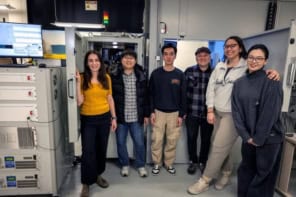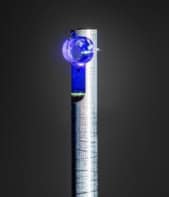New synchrotron radiation sources are coming on-line all over the world. But the only facilities that produce ultraviolet wavelengths are being closed down.
Synchrotron radiation is now used routinely in many areas of science. Many research groups, especially in physics, chemistry and biology, base large parts of their research programmes on the use of this type of radiation. There are also increasing numbers of scientists who find that a few days’ work at a synchrotron radiation source can provide crucial information to complement their main laboratory-based research. Some of the best examples of this are in protein structure and materials characterization, in which X-ray diffraction and X-ray absorption fine-structure techniques are commonly used.
This widespread applicability of synchrotron radiation is reflected in the growing number of new sources that have recently been built or are being planned or constructed – in many cases in countries where no such facilities previously existed, such as Brazil, Taiwan, Korea, India and Switzerland. Other countries, including Japan, the US, Italy, Germany and Sweden, have facilities that have just opened or are about to open, while the UK is currently debating whether to build a new source called DIAMOND.
Synchrotron radiation is the name given to the light that is emitted when very high-energy electrons or positrons are bent in magnetic fields. The radiation covers a wide and continuous spectral range, from the infrared region to “hard” X-rays at energies above 20 keV. The light is emitted as a narrow cone, enabling large numbers of photons to be delivered to an experiment.
In the early days of synchrotron radiation research in the 1970s, the light was taken “parasitically” from electron accelerators that were built and used for high-energy physics. These “first-generation” machines used bending magnets to contain the electrons in a circular path while they were being accelerated. The synchrotron radiation emitted as the electrons passed through these magnets could be extracted with no disadvantage to the particle physicists working on the machine.
The “second-generation” sources from the 1980s are purpose-built electron storage rings, in which the electrons, once accelerated, are made to orbit the ring at a fixed kinetic energy. These storage rings have beams with half-lives of up to 48 hours and provide a much more stable source of synchrotron radiation than the earlier machines. However, these are still designed to exploit the radiation emitted at the bending magnets.
Third-generation sources
The newest facilities – the “third-generation” sources – exploit so-called insertion devices. These are special magnetic structures that are inserted into the straight sections between the bending magnets on a storage ring. They allow each beamline to have its own spectral characteristics. The two principal types of insertion device – undulators and multipole wigglers – both consist of a linear array of alternating magnetic dipoles, which cause the electron beam to undulate or wiggle about the nominally straight trajectory. The oscillating electrons emit electromagnetic radiation.
The radiation emitted by a multipole wiggler is similar to that of a conventional bending magnet, but if the device has N pairs of magnetic dipoles, the total amount of light emitted is N times greater than from a single bend. The other advantage of multipole wigglers is that they often have higher magnetic fields than the bending magnets. This forces the electrons to travel round tighter bends, delivering more radiation at higher energies.
In contrast, undulators typically have a lower local field than wigglers. However, the radiation emitted at each equivalent point in the periodic oscillating trajectory is temporally coherent, which leads to constructive interference. The emitted radiation is strongly peaked at one particular photon energy – and higher harmonics of this energy – and is emitted in a cone that is even narrower than the radiation produced by conventional bending magnets.
Undulators, in particular, are very attractive sources of radiation. The narrow cone angle means that the “spectral brilliance” – the number of photons per unit area per unit solid angle – is exceptionally high, while the harmonic character of the radiation means that a large amount of radiation power is concentrated at the wavelength of interest. However, the photon energy at which this peak power is generated is directly related to the spatial period of the magnetic array, and although this energy can be tuned by changing the magnetic-field strength, the range is relatively narrow. Typically, an undulator can deliver high-brilliance radiation over a photon-energy range of a factor of no more than 20-40. This tuning range is much narrower than that available from the bending-magnet synchrotron radiation continuum. In other words, the choice of machine energy is vitally important for third-generation sources, since it is so closely matched to the photon energies of interest.
Missing spectral regions
Since undulators produce only a narrow band of photon energies, the scientific community needs synchrotron radiation sources with a significant range of characteristic machine energies. The problem is that all of the new synchrotron sources are clustered round just two energy values. First there are new sources that are optimized to produce X-rays with energies of 2-50 keV – namely the 6 GeV European Synchrotron Radiation Facility in Grenoble, France, the 7 GeV Advanced Photon Source at the Argonne National Laboratory in the US and the 8 GeV Super Photon Ring in Harima Science Garden City, Japan. Then there are sources that have machine energies between 1.2 GeV and 2 GeV, which produce undulator radiation in the range 50-2000 eV. Two other planned machines (DIAMOND in the UK and SOLEIL in France) will have energies lying between these two extremes, while multipole wigglers offer access to even higher photon energies at all of these facilities.
What is conspicuous is the absence of any plans to build third-generation sources that are optimized for lower energy, vacuum ultraviolet (VUV) radiation, especially in the 5-50 eV range. These sources would have a machine energy of about 0.5 GeV. To make matters worse, several existing second-generation machines, which are used extensively for this photon-energy range, are likely to close down as the new facilities come on-stream, mainly for reasons of running costs.
The problem is particularly acute in Europe, where one might have thought that national science policies in this field could be rationally coordinated. However, four third-generation machines with energies in the 1.2-2.0 GeV range are either already in operation or being built. These are the ELETTRA source in Trieste, Italy, MAX II in Lund, Sweden, BESSY II in Berlin, Germany, and the Swiss Light Source in Villingen. The BESSY lab, meanwhile, has recently announced that its second-generation source, BESSY I, will close in 2000, with the run-down actually starting later this year. It is also rumoured that SUPER-ACO in Orsay, France, will be shut down shortly after construction of SOLIEL is planned to begin.
Beamline closures
It therefore seems likely that in the next five years or so there will be a big increase in both the number and quality of synchrotron radiation facilities that produce photons with energies above about 50 eV, but a major reduction in lower-energy beamlines. It is perhaps ironic that the Birgeneau committee in the US recently concluded – in connection with the Advanced Light Source, a new 1.5-1.9 GeV third-generation facility in Berkeley – that the number of important scientific issues that require “soft X-ray” sources (photons at energies of about 500-2000 eV) has declined in the last few years compared with those issues that need higher-energy hard X-rays (Physics World November 1997).
We feel that the loss of vacuum-ultraviolet facilities and the failure to exploit fully the potential of third-generation sources in this energy range are, at the very least, extremely unwise. There is, after all, important science to be done here. Some of the clearest information on the nature of high-temperature superconductivity has come from angle-resolved photoemission in this energy range, a technique that can enable the occupied electronic bands to be mapped directly. For example, German researchers led by Jörg Fink have recently used the BESSY source to identify two Zhang-Rice singlet states associated with the different cuprate sublattices of Ba2Cu3O4Cl2 (1997 Phys. Rev. Lett . 78 4107). Such experiments need the high flux and spectral resolution that are most easily obtained from undulator sources. VUV radiation also offers a powerful source of photons for molecular photochemistry and for a more complete understanding of atomic physics. Recently, for example, a team of British and German physicists led by Hans Kleinpoppen and Uwe Becker studied the magnetic dichroism in photoemission from atomic oxygen (1996 Phys. Rev. Lett. 77 2642).
A common myth is that synchrotron radiation in this energy range is not necessary because lasers can now – or soon will – provide much better sources for these experiments. It is a myth because the characteristics of synchrotron radiation and lasers are intrinsically different, although complementary. Synchrotron radiation can be tuned over a wide range of energies, and has a high average power and a time structure that is effectively continuous for most experiments. Lasers, on the other hand, offer much higher instantaneous power and spectral resolution, but limited or slow tunability. Very few experiments could sensibly be transferred between these two types of source without major restrictions.
Answers, please
The underlying difficulties in rectifying this problem of a lack of VUV sources are twofold. The first is a mixture of fashion and misunderstandings, while the other is financial. One important technical misunderstanding is the role of “electron-beam emittance”, which is the angular spread of the electrons multiplied by the effective source area. The angular spread of the radiation emitted by the electrons cannot be smaller than the angular spread of the electrons themselves. This has encouraged the designers of third-generation sources to aim for lower and lower electron emittances, which has tended to make these machines more complex and more expensive, with beams that do not last as long.
In the VUV region, in contrast, the intrinsic angular spread of the radiation is larger, and low electron-beam emittances are neither necessary nor desirable. However, there is a common belief that lower-emittance machines are old-fashioned and so are not worth building or maintaining. Moreover, the political trend for some years has been to fund sources in the 1.2-2 GeV range, such as ELETTRA, BESSY II and the Advanced Light Source, which offer more immediate impact in applied research in areas like surface analysis and deep lithography. Financial aspects play a role too. In at least one case (BESSY) a perfectly sound second-generation machine is being shut down to save running costs in order to support a new, higher-energy replacement machine. A similar fate appears to await Super-ACO. BESSY I, for example, could easily be upgraded to near-optimal VUV performance with quite modest expenditure.
It is hard to see a solution to this problem. Somewhat perversely, the fact that optimal VUV sources are significantly cheaper than soft or hard X-ray machines – coupled with the fact that they are smaller and can thus handle fewer users at the same time – means that they are not attractive compared with international projects like the European Synchrotron Radiation Facility. On the other hand, with the possible exception of Denmark, no national funding agency seems prepared to commit itself to the creation of a low-energy VUV facility.
The real solution might be to not have national VUV facilities – nor even a single European facility – but rather several machines shared between a group of nations. Some of these could conceivably be obtained by simply upgrading existing sources, such as Super-ACO or BESSY I. In principle, the European Union could be an ideal source of such an initiative, but it is hard to see this happening – especially as we need rapid action if the existing VUV machines are to be saved.



